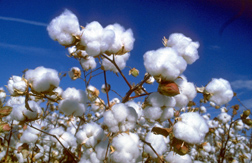This page has been archived and is being provided for reference purposes only. The page is no longer being updated, and therefore, links on the page may be invalid.
|
|
Cotton Studies Target Killer: Fusarium Wilt
By Marcia WoodMarch 20, 2008
The long, warm days of a typical California summer make life easy for sun-loving cotton plants. But a fungal enemy that causes what's known as Fusarium wilt can make things tough for the plants—and for growers' balance sheets, too.
That's why Agricultural Research Service (ARS) plant pathologist Rebecca S. Bennett is researching environmentally friendly ways to fight the fungus. Bennett works at the ARS Western Integrated Cropping Systems Research Unit in Shafter, Calif.
Researchers know the troublesome fungus as Fusarium oxysporum f.sp. vasinfectum, or FOV race 4. A soil-dweller that was first detected in California in 2001, FOV race 4 can clog a plant’s "plumbing," or vascular system, eventually causing its leaves to yellow, wilt and die. Yields of the afflicted plant's fluffy white bolls may plummet.
In a 3-year study, Bennett is looking at solarization, in which soil covered with plastic tarps might capture enough heat from the sun's rays to kill the fungus. Though solarization is likely too expensive to use on a widespread basis on cotton fields, it might be economical for spot-treating highly infested sites, Bennett said.
Bennett also is collaborating with plant pathologist Tom Gordon of the University of California-Davis on an indoor study of the microbe. In that experiment, Fusarium will be specially equipped with a gene that gives it a bright green glow when viewed with ultraviolet light in the lab. The telltale glow will make it easier for Bennett and Gordon to spy on the fungus and, perhaps, to find a way to bring about its demise.
Related work by other scientists at Shafter and elsewhere focuses on a different strategy: to breed superior cotton plants that have impressive natural resistance to the microbe.
ARS is the U.S. Department of Agriculture's chief scientific research agency.

